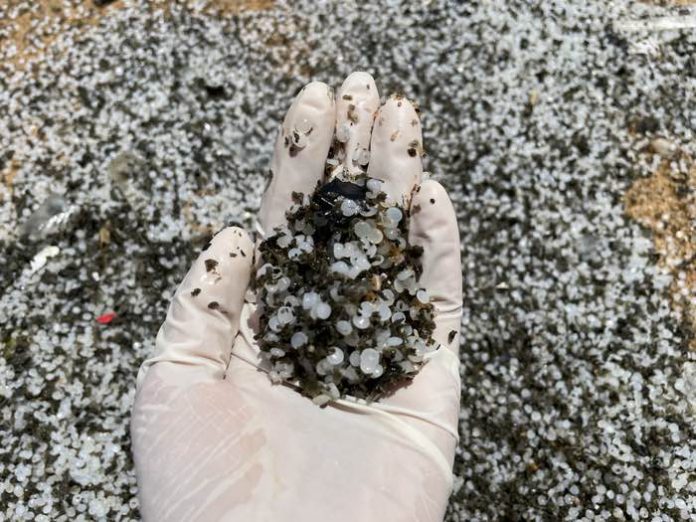
When a fire broke out on the deck of the M/V XPress Pearl cargo ship on May 20, 2021, an estimated 70-75 billion pellets of preproduction plastic material, known as nurdles, spilled into the ocean and along the Sri Lankan coastline. That spill of about 1,500 tons of nurdles, many of which were burnt by the fire, has threatened marine life and poses a complex clean-up challenge.
A new peer-reviewed study characterizes how the fire modified the physical and chemical properties of the nurdles and proposes that these properties affected their distribution along the coast. The study, published today in the journal ACS Environmental Au, also provides guidance for the continuing clean-up and monitoring effort and for any potential future nurdle spills, whether in Sri Lanka or elsewhere.
Among the recommendations are educating and empowering citizen scientists to continue safely reporting nurdle sightings to inform clean-up efforts; accounting for the ship’s onboard cargo to better gauge future threats from the wreck; continuing the urgency for clean-ups while also revising response efforts to account for any variability of spilled nurdles; and encouraging locally led research efforts on nurdle samples.
“One key impact of this paper is providing actionable and relevant data and recommendations during an ongoing response,” said co-author Chris Reddy, senior scientist in the Woods Hole Oceanographic Institution’s (WHOI) Marine Chemistry and Geochemistry Department.
Reddy said that he and other scientists at WHOI became involved almost immediately with studying the nurdles and their potential impact, and they have worked closely on this issue with scientists in Sri Lanka and elsewhere. Reddy added that because the properties of the unburnt and burnt nurdles are different, the spill almost amounts to two separate spills that potentially call for different clean-up strategies.
“Exposure to combustion, heat, and chemicals led to agglomeration, fragmentation, charring, and chemical modification of the plastic creating an unprecedented, complex spill of visually burnt and unburnt nurdles,” according to the study, The M/V X-Press Pearl nurdle spill: Contamination of burnt plastic and unburnt nurdles along Sri Lanka’s beaches. “The burnt nurdles span a continuum of colors, shapes, sizes, and densities with high variability that could impact clean-up efforts, alter transport in the ocean, and potentially affect wildlife,”
The study notes that the fire increased the chemical complexity of the plastics up to three-fold, and that burnt nurdles could “camouflage among natural materials” and could break into even smaller pieces because of their brittleness.
The key messages of the study include the fact that some of the burnt nurdles don’t even look like plastic anymore, and that this should be considered during the clean-up, said co-author Anna Michel, associate scientist in WHOI’s Department of Applied Ocean Physics and Engineering. Michel said that she and other WHOI scientists interested in microplastics science quickly utilized multiple labs–including her own lab, which has been developing instrumentation to study microplastics in the ocean and in freshwater–and worked across disciplines to eke out data about the nurdles.
“Another key message is the importance of having international collaborators who can work together when an incident like this happens, where a lab can pivot and make measurements that could help to inform the response to a spill,” Michel said.
“Building an international collaboration in a time of crisis means that we can work faster to get the answers that are crucial for supporting the recovery efforts. It is also key that the initiative is locally-led: this ensures that we are responding to the needs on the ground,” said paper co-author Asha de Vos, founding executive director of Oceanswell, Sri Lanka’s first marine conservation research and education organization. The Oceanswell nurdle tracker provided an opportunity for Sri Lankans across the coastline to participate in science from the safety of their own backyards.
De Vos added, “For me, this is very personal. Sri Lanka is my home, and the ocean is critical to life here and around the world. I want to ensure that I am using my scientific skills to help understand the issues we face and produce science that is useful in the long recovery phase.”
“While there have been massive releases of nurdles from container ships in the past, this event was different,” said co-author Bryan James, a postdoctoral scholar in WHOI’s Marine Chemistry and Geochemistry Department. Unlike previous nurdle spills, this spill released burnt plastic, which is a type of litter that has only recently been documented in the ocean. The burnt plastic poses uncertainties for response activities, its fate and transport, and its potential impact on wildlife, researchers noted.














